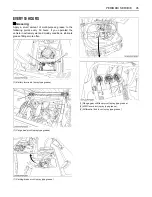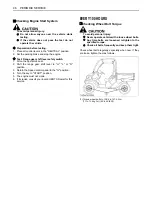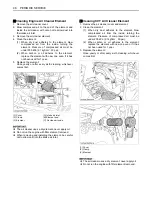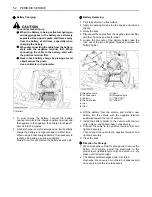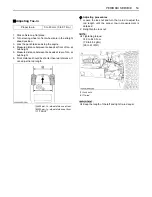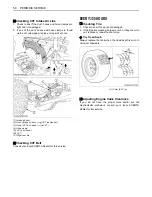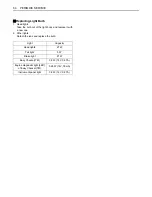
PERIODIC SERVICE
52
C
Battery Charging
To avoid personal injury:
A
When the battery is being activated, hydrogen
and oxygen gases in the battery are extremely
explosive. Keep open sparks and flames away
from the battery at all times, especially when
charging the battery.
A
When disconnecting the cable from the battery,
start with the negative terminal first. When
connecting the cable to the battery, start with
the positive terminal first.
A
Never check battery charge by placing a metal
object across the posts.
Use a voltmeter or hydrometer.
1. To slow charge the battery, connect the battery
positive terminal to the charger positive terminal and
the negative to the negative, then charge for at least 1
hour at 6 to 10 amperes.
2. A boost charge is only for emergencies. It will partially
charge the battery at a high rate and in a short time.
When using a boost-charged battery, it is necessary to
recharge the battery as early as possible.
Failure to do this will shorten the battery's service life.
C
Battery Replacing
1. Park the vehicle on a flat surface.
2. Apply the parking brake, stop the engine and remove
the key.
3. Raise the seat.
4. Disconnect the cables from the negative terminal first,
and then from the positive terminal.
5. Loosen the two nuts of the battery holder, take the
rods out of the two elongated holes and remove the
battery holder.
6. Lift the battery from the vehicle, and install a new
battery into the vehicle with the negative terminal
positioned toward the rear of vehicle.
7. Install the battery holder to the vehicle with the two
nuts in place, and tighten these nuts securely.
8. Connect the cable to the positive terminal first, and
tighten it securely.
Then connect the cable to the negative terminal, and
tighten it securely.
9. Close the seat.
C
Direction for Storage
1. When storing the vehicle for a long period, remove the
battery from vehicle, adjust the electrolyte to the
proper level (refillable type only) and store in a dry
place out of direct sunlight.
2. The battery self-discharges while it is stored.
Recharge it once every 3 months in hot seasons and
once every 6 months in cold seasons.
(1) Battery
(1) Negative cable
(2) Positive cable
(3) Battery
(4) Battery holder
(5) Nut
(6) Rod
(A) Seat
(B) Elongated hole
(C) "TAKE OUT"
(F) "FRONT"
Summary of Contents for RTV400
Page 1: ...1AYAACPAP0010 READ AND SAVE THIS MANUAL OPERATOR S MANUAL UTILITY VEHICLE R T V 4 0 0 C i...
Page 14: ...5 SAFE OPERATION 7 DANGER WARNING AND CAUTION LABELS...
Page 15: ...SAFE OPERATION 6...
Page 16: ...7 SAFE OPERATION...
Page 17: ...SAFE OPERATION 8...
Page 19: ......
Page 91: ...R T V 4 0 0 C i English U S A Code No K7211 7121 1 PRINTED IN U S A KUBOTA Corporation 2011...








